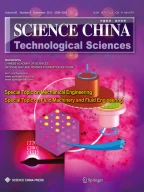Abstract
Based on the multiple wedge effects, a petal-shaped capsule robot (PCR) is proposed, and the self-centering phenomenon of the PCR is discovered. For investigating the self-centering characteristics, an innovative concept of the instantaneous fluid membrane (FM) thickness, along with the dynamic FM thickness, is proposed; thus a dynamic FM thickness model and a hydrodynamic pressure (HP) model are derived when the PCR axis deviates from the pipe axis under the effect of gravity. A kinematics equation during suspending process in the vertical direction and a swimming kinematics equation in axial direction are derived respectively. Four capsule robots with different eccentricities of the tiles were manufactured and tested, the theoretical and experimental results show that the HP gradient is a fundamental reason for the self-centering phenomenon. The PCR with the self-centering ability can directly avoid the contact with the bottom of the gastrointestinal (GI) tract, achieving the excellent obstacle surmounting ability in the GI complex environment with the less twisted impact on the GI tract, which has a promising application prospect in the GI diagnosis.
Similar content being viewed by others
References
Moglia A, Menciassi A, Schurr M O, et al. Wireless capsule endoscopy: From diagnostic devices to multipurpose robotic systems. Biomed Microdevices, 2007, 9: 235–243
Ni Z Q, Wang T M, Liu D. Survey on medical robotics. J Mech Eng, 2015, 51: 45–52
Sehyuk Yim, Gultepe E, Gracias D H, et al. Biopsy using a magnetic capsule endoscope carrying, releasing, and retrieving untethered microgrippers. IEEE Trans Biomed Eng, 2014, 61: 513–521
Zhang Y. Trafficability characteristic and magnetic vector control of a capsule robot in bending environment. JME, 2014, 50: 26–32
Park H, Park S, Yoon E, et al. Paddling based microrobot for capsule endoscopes. In: Proceedings of the 2007 IEEE International Conference on Robotics and Automation. Piscataway: IEEE, 2007. 3377–3382
Valdastri P, Webster R J, Quaglia C, et al. A new mechanism for mesoscale legged locomotion in compliant tubular environments. IEEE Trans Robot, 2009, 25: 1047–1057
Tortora G, Valdastri P, Susilo E, et al. Propeller-based wireless device for active capsular endoscopy in the gastric district. Minimally Invasive Ther Allied Technologies, 2009, 18: 280–290
Liang H, Guan Y, Xiao Z, et al. A screw propelling capsule robot. In: Proceedings of the 2011 IEEE International Conference on Information and Automation (ICIA). Piscataway: IEEE, 2011. 786–791
Woods S P, Constandinou T G. Wireless capsule endoscope for targeted drug delivery: Mechanics and design considerations. IEEE Trans Biomed Eng, 2013, 60: 945–953
Temel F Z, Erman A G, Yesilyurt S. Characterization and modeling of biomimetic untethered robots swimming in viscous fluids inside circular channels. IEEE-ASME T Mech, 2013, 19: 1562–1573
Zhang Y S, Wang D L, Guo D M, et al. Characteristics of magnetic torque of a capsule micro robot applied in intestine. IEEE Trans Magn, 2009, 45: 2128–2135
Zhang Y. Petal shape optimization of a capsule robot with multiple wedge effects. JME, 2015, 51: 45
Pinkus O, Sternlicht B, Saibel E. Theory of Hydrodynamic Lubrication. New York: McGraw-Hill, 1961. 47–61
Szeri A Z. Fluid Film Lubrication. Cambridge: Cambridge University Press, 2011. 628–632
Yang J X. Mechanics (in Chinese). Hefei: Press of University of Science and Technology of China, 2004
Zhang Y. Petal-shaped capsule robot with high performance. JME, 2017, 53: 9–16
Zhang Y, Chi M, Su Z. Critical coupling magnetic moment of a petal-shaped capsule robot. IEEE Trans Magn, 2016, 52: 1–9
Author information
Authors and Affiliations
Corresponding author
Rights and permissions
About this article
Cite this article
Zhang, Y., Chen, J., Zhang, Y. et al. Self-centering characteristics of a petal-shaped capsule robot. Sci. China Technol. Sci. 62, 619–627 (2019). https://doi.org/10.1007/s11431-017-9261-3
Received:
Accepted:
Published:
Issue Date:
DOI: https://doi.org/10.1007/s11431-017-9261-3
